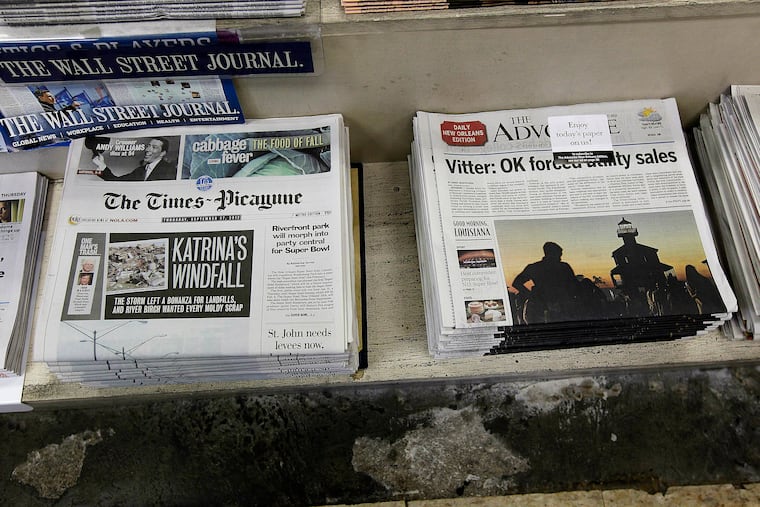News industry resorts to layoffs, cutbacks as ad revenues plunge during coronavirus pandemic
Ad sales, the life blood of most traditional news organizations, have fallen by between 30 and 50 percent in the recent weeks as businesses temporarily closed.

The news industry, already battered by more than a decade of declining revenues, is getting walloped by another body blow.
Advertising sales, the life blood of most traditional news organizations, have plunged by 30% to 50% in recent weeks as Main Street businesses have temporarily closed to slow down the spread of the COVID-19 epidemic.
“It’s a mess,” said news industry analyst Ken Doctor. “We could be approaching an extinction event for some publishers. It will depend on the condition of those businesses before the virus, and how long this whole thing lasts.”
Up to 10% of American daily newspapers were unprofitable before the pandemic hit, he said.
“We’ll see several of those literally close their doors and die."
The good news: Tucked within the $2 trillion stimulus package — passed by the U.S. Senate this week, and expected to be approved by the House — is money that could be apportioned to keep viable local news organizations up and running.
Newspaper companies with 1,000 or fewer employees can apply for a loan of $1 million at a maximum interest rate of 4%.
About 80% of American newspaper companies have fewer than 1,000 employees, Doctor said. Large chains such as McClatchy and Tribune may apply for what has become known as “Mnuchin’s Fund,” a $500 billion pile of cash slated for big industry and named after U.S. Treasury Secretary Steven Mnuchin.
As the coronavirus wipes out advertising revenue, newsrooms across the country continue to lay off journalists even as more readers than ever are accessing local newspapers and websites for reliable information about the pandemic that has killed at least 1,000 people in the U.S. as of Thursday.
» READ MORE: Will coronavirus kill off the news business just when America realized we actually need it? | Will Bunch
The Tampa Bay Times last week laid off about a dozen journalists following an announcement in February that all employees would see a 10 percent pay cut.
The New Orleans Times-Picayune and Advocate last week announced it was furloughing about a tenth of its 400-member workforce. Hardest hit were reporters and editors covering sports and culture as those activities came to a grinding halt when governments across the country ordered non-essential businesses to shut down. The remaining employees will work four-day weeks.
The Pittsburgh Tribune-Review last week combined its two print editions and laid-off many of its staff, including Seth Rorabaugh who covered the Pittsburgh Penguins. The Boston Globe is laying off 50 mailroom workers and offering buyouts to 55 more.
Meanwhile, newspaper websites such as Inquirer.com are attracting a record number of readers.
“This is the best of times and the worst of times in local news," said Jim Friedlich, executive director and CEO of the Lenfest Institute for Journalism, a nonprofit that supports sustainable local news and is the owner of The Inquirer. The Inquirer is now the largest American newspaper owned by a nonprofit.
“Our news has never been more valuable or more valued by our communities, and yet we face the same economic challenges as the local markets we serve,” Friedlich said.
Meanwhile, the crisis forced by the pandemic has refocused readers on local news, said David Chavern, president of the News Media Alliance and American Press Institute in Arlington, Va.
“There had been a general trend of readers paying more attention to national stories, an internet phenomenon accelerated by Trump,” Chavern said. “Now the magnifying lens has been turned around.
"People have an intense need to know what’s happening in their county, their schools. They want to know where their local testing stations are. Local news is literally saving people’s lives right now.”
The skyrocketing number of page views, however, isn’t translating into increased revenues.
In an informal survey of about 20 publishers last week, the International News Media Association (INMA) found its members bracing for “a ferocious impact” — a 55% collapse in advertising revenues.
For those businesses that continue to stick with newspapers, many don’t want their ads to appear with stories about the coronavirus.
“The best balm for this illness is reader revenue through subscriptions,” said Doctor. “We’ve seen an increase of two to five times in the number of digital subscription starts over the past two weeks. That’s ongoing revenue. It’s not subject to advertising."
While the coronavirus coverage largely is being offered as a free community service, several major newspapers, including The Inquirer, are seeing an upsurge in both digital subscriptions and public donations.
“As the saying goes, ‘never let a crisis go to waste’,” said Friedlich. “The good news in all of this is that the COVID-19 crisis appears to be accelerating the transition to a greater level of community financial support for local journalism.
“The focus on page views translating to digital ad revenue has proved a mirage," Friedlich continued. "Most local newspapers are focused now on loyal reader engagement rather than ‘eyeballs.’ Loyal readers convert over time to paying digital subscribers, the life-blood of newspapers in the years ahead.”